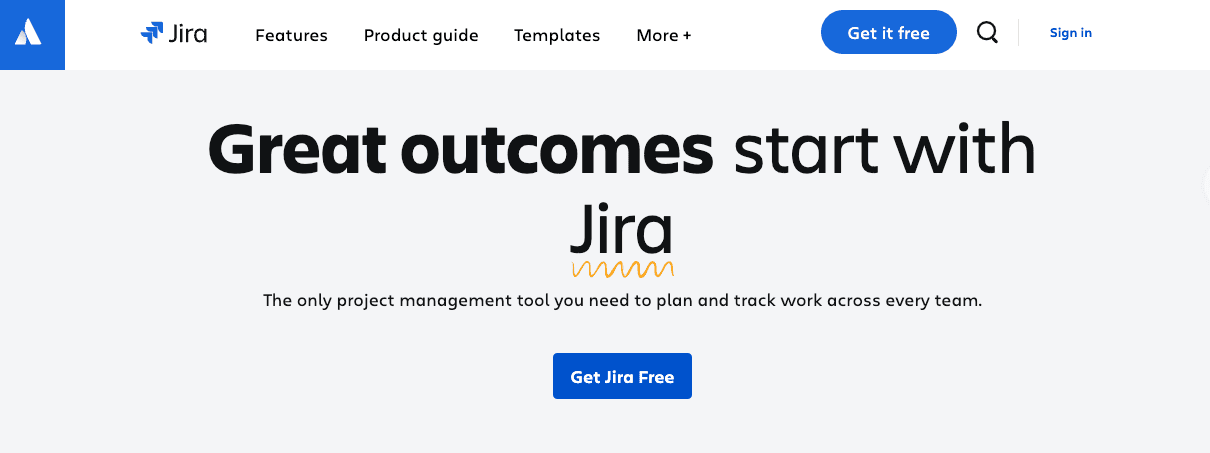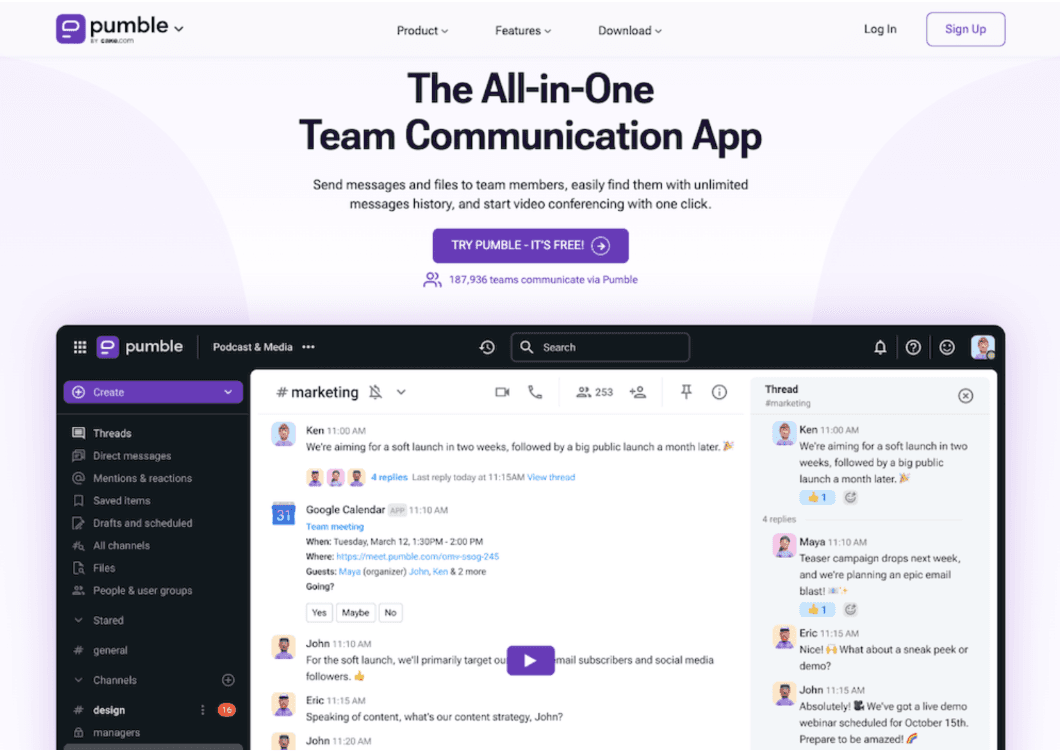You read an important system-wide email about a new policy change. So you're eager to discuss it with your team. But then the meeting starts. Half the team missed the message or couldn't access the resources. Now, they're out of the loop, and your department is scrambling to stay on track.
That's not a scenario anyone wants. And thankfully, your team can eliminate team misalignment with internal communication software.
Not only does internal comm software prevent misunderstandings and delayed projects, but it also increases productivity. Over 58% of the American workforce works at least a day at home, and the global workplace increases remote work by 8%. Whether you have an on-site, hybrid, or distributed workforce, your teams need the right tools to manage communication.
With the right live and asynchronous tools, they can effectively provide feedback on designs or provide code reviews, remain accountable during project sprints, and share ideas packed with essential context and personality—or even simply ensure everyone is included in announcements about company-wide initiatives.
The benefits of internal communication software
According to the Institute for Collaborative Working, better teamwork increases customer satisfaction by 41%. When customers are happy, revenue often goes up, too. Gallup reports that higher team collaboration and engagement produce 23% more profitability.

Team engagement and collaboration depend on the quality of your communication.
Since there are often many communication avenues within an organization—from quick chats to clarify minor details to company-wide vision planning or policy implementation—there are a few key questions to answer when assessing your current internal communication needs. For example:
Can all of your teams provide tight feedback loops throughout a project pipeline? Internal communication tools like video or chat can help improve projects through the collaboration stage.
Can the customer service team voice unresolved pain points to leadership? Internal comms tools can help customer service reps illuminate common frustrations and themes before they become bigger problems.
Can your sales team inform the marketing team of a common but unaddressed pain point that’s trending with leads? A sales team can collaborate with their marketing team to tackle hesitations and win new customers.
Maximizing your internal communication software can help you facilitate team alignment and create an improved organizational culture. These improvements can boost collaboration for projects, events, updates, and day-to-day workflows across all departments—like cross-functional team collaboration.
1. Loom: Convenient video messaging
Loom’s video messaging platform lets teams engage without clocking into a live meeting. With just one click, it's easy to record a Loom video message, simultaneously capturing your ideas with the free screen recorder in real-time. This allows for point-of-view (POV) experiences that drive tighter feedback loops, add context before and after live meetings, and improve project collaboration.

Features:
Dynamic recording: Capture your screen and your body language via webcam for detailed context that live meetings or emails often miss to fully provide.
More engagement: Get real-time feedback from your viewers, who can type in a comment or send an emoji while watching the video. Viewers with a Loom account can also reply with their own video to interact whenever and wherever they want.
Edit in an instant: Restart a recording from where you left off if you made a mistake, easily trim videos, and more with Loom’s editing features.
Easy sharing: Send your video message using an instantly shareable link, email, or as an embed on your wiki or web page.
AI power: Use the paid Loom AI add-on to reduce time spent editing and sharing your messaging. It automatically removes filler words and silent pauses and generates video titles, summaries, and chapters.
Pros:
Loom’s video style is casual, so anyone can record without pressure while communicating effectively.
The app is user-friendly and compatible across multiple devices, whether you’re using the Chrome browser extension, the mobile app, or the desktop app.
Your teams can free up their calendars to accomplish deep work, still communicating often without the common challenges of coordinating live meetings.
Cons:
While Loom is free, teams need a paid plan for longer recording sessions or AI features.
Pricing: Loom’s base plan is free. The Business plan is $12.50 monthly, billed annually.
2. Workvivo: A company intranet solution
Workvivo by Zoom is a modern intranet software for internal communication. Employees can engage with each other within a dedicated internal social ecosystem. They can share articles, comment, chat, and live stream for engagement and collaboration.

Features:
Bridge the gap: Connect your entire organization from top to bottom to maximize employee engagement and retention.
Give and receive: Celebrate employee accomplishments with badges, awards, shout-outs, and kudos. Learn more about your employee’s needs and innovative ideas with surveys and polls.
Simplified tools: Embed external resources into Workvivo with numerous integrations, including Google Workspace, Office 365, Hubspot, Confluence, Workday, Slack, Okta, and more.
Versatile digital workspace: Chat, live stream, and share files in one place—connecting and collaborating in whichever form of communication suits your team or project needs best.
Pros:
Users report that Workvivo is very easy to use
Customers say its integrations are smooth and reliable.
Cons:
Some users report having difficulty using specific features, like how to post a shout-out.
Some customers complain about the initial onboarding setup.
Pricing: Workvivo provides custom quotes with pricing dependent on a team’s needs and size.
3. Flock: Team chats
Flock is a team chat platform and a great alternative to Slack. It organizes discussions by channel, making it easy for teams to communicate with each other based on projects, departments, and clients or accounts.

Features:
Effective connection: Keep team comms organized, action items clear, and resources accessible with channel messaging, video conferencing, integrated search, and voice notes.
Virtual office: Use Flock in your browser, a desktop app, or on your phone.
Fully-stocked app store: Be more productive and less distracted when the essentials are all in one intuitive workspace, thanks to integrations with numerous file and project management, sales, customer support, and developer apps.
Pros:
Flock is user-friendly, and chatting with coworkers and creating group chats is super easy.
The platform has many integrations with CRM and project management tools, such as Asana, Trello, Google Calendar, and GitHub.
Cons:
If companies add too many channels, Flock can overwhelm the team.
Leaders must intentionally create expectations and boundaries to avoid encroaching on employees outside of working hours, on weekends, and during time off.
Pricing: Flock is free. The Pro plan starts at $6 monthly.
4. Jira: Project management
Popular among software development teams, Jira specializes in agile project management that allows teams to plan and track their projects with customizable workflows like Kanban boards. Employees can also assign tasks and detailed information for each action, such as requesting a code review or assigning a revision for a design project.

Features:
End-to-end performance: Plan, track, collaborate, and report on your projects—and use your successes as templates for powerful iterative results.
Clear accountability: Jira users can add expectations, action steps, and responsibilities per team user to ensure nothing slips through the cracks.
Custom flow: Track your team’s progress in the way they work best, whether it’s a list view, Kanban board, timeline, sprints, or backlogs.
Robust tracking: Keep your projects and the resources needed to accomplish them at your fingertips with task details like dependencies and numerous integrations.
Pros:
Teams and project managers can communicate responsibilities and project goals from anywhere they work.
Versatile tracking and integration options mean Jira isn’t limited to developers—marketing, design, and customer support teams can successfully manage their projects.
Cons:
While Jira has a free plan, businesses must upgrade it to meet all their workflow needs.
Pricing: Jira is free. Paid plans start at $7.16 monthly.
5. Thrive: Cohesive team comms
Since people already spend a lot of time on their phones, why not create an internal app for employees? Leaders can use the Thrive app to keep their entire workforce informed and engaged and even put essential company resources at employees’ fingertips with intuitive CMS features.

Features:
Resource hub: Provide all the information your teams need in one app, whether it’s new-hire onboarding content or standard operating procedures.
Company-wide notifications: Make announcements, publish resources, and keep employees updated about important updates or policy changes.
Employee perks: Keep your teams’ company benefits and rewards accessible by creating a dedicated store for them to peruse when it’s convenient.
Boost morale: Highlight your employees’ successes on one or across the entire company, building a positive and inclusive culture where everyone feels valued.
Pros:
Thrive is an efficient option for an accessible company hub.
Leaders can easily communicate changes to company policies, exciting updates, or employee recognition.
Cons:
The app lacks more interaction and engagement opportunities for team members, risking a static experience.
Pricing: While Thrive has a Lite plan, companies needing full capabilities for their teams need to request a custom price for the Enterprise plan.
6. Pumble: A Flock team chat alternative
Pumble is another option for team chats. Team members can send messages or files to remote coworkers for collaboration. Pumble has unlimited instant messaging features, and employees can also start a video conferencing session through the app.

Features:
Effortless communication: Keep your projects and conversations organized by topic in channels or spin discussions off into threads, and easily share files or chat with team members one-on-one.
All-in-one convos: No need to leave Pumble to host a video call, collaborate, or share a document.
Searchable records: Track down details with unlimited message histories and record live calls for later reference.
Informed stakeholders: Invite external guests into your spaces so they can access crucial information or provide valuable input, even if they don’t use Pumble day-to-day.
Pros:
Pumble makes it easy to organize chats, share company news and milestones, and engage with remote team members.
The platform includes audio, video calls, file sharing, and chat features.
Cons:
Some users say the app doesn’t offer great support.
Users often voice that they want more customization with digital workspaces, like changing colors and themes.
Pricing: The Enterprise plan with all features starts at $7.99 monthly.
7. Confluence: Brainstorming and resource management
Confluence provides a wiki-like whiteboard platform for team collaboration and communication. Teams can use its brain-map resource for planning boards, wiki pages, and structured notes. It’s an excellent option for remote, hybrid, and distributed teams.

Features:
Unlimited notes: Publish pages and spaces for resources and documentation without worrying about storage capacity.
Don’t start from scratch: Leverage templates to save time and start right away by using a pre-built document setup.
Versatile whiteboards: Kick-off projects with diagrams, flow charts, and brainstorming templates—then huddle up and debrief with team retrospectives.
AI features: Use the AI editor to round out your Confluence pages.
Pros:
Confluence adds structure to brainstorming sessions and empowers collaboration with its wiki and brain-map style interface.
Leaders can control user access and permissions on the paid plan.
Cons:
Businesses must upgrade to a paid plan to access all the features for a fully collaborated team.
Some users want more customizations, such as different designs and colors.
Pricing: Confluence is free. Paid plans start at $4.89 monthly.
8. GoTo Meeting: Live video calls
GoTo is a live video tool and a Zoom alternative for remote workplaces. Hybrid and distributed teams can easily use the live app to set up a meeting, share a link so attendees can access the meeting, and then work together.

Features:
Meeting tools: Collaborate and innovate during your meetings with screen sharing, breakout rooms, drawing tools, and keyboard and mouse sharing.
Strong security: Use single sign-on, lock conferences, or remove guests as needed.
Quality audio: Host professional, productive meetings with built-in VoIP and toll audio and background noise suppression.
Pros:
GoTo’s 99.999% service uptime makes it a reliable solution for meeting live.
Users can easily share a link and control who can join meetings.
Cons:
Not everyone can meet simultaneously because of busy schedules and time zones.
If teams don’t want their calendars to be overwhelmed, they’ll need to be intentional about live vs. asynchronous communication practices.
Pricing:
GoTo Meeting starts at $14 monthly, billed annually.
9. Contact Monkey: Employee text message alerts
Sometimes, all you need is to convey an urgent message or send a critical reminder, not necessarily meet up to collaborate. Contact Monkey’s employee text message feature allows teams to immediately send red alerts, such as IT emergencies or essential notes, right to their mobile phones.

Features:
Informed teams: Keep your on-site and remote teams up to speed with critical alerts for safety, deadline or training reminders, and policy or company announcements.
Two-way street: Collect feedback from your teams with surveys and polls.
Performance tracking: Get metrics and analytics on the effectiveness of your text messages.
Pros:
Leaders can immediately contact teams wherever they are.
Informative texts can keep employees engaged and connected without having to hunt down event invites, reminders, or links.
Cons:
Employees may not like text alerts on their phones since text messages are often considered more personal.
Text message announcements might fail to provide entire team engagement by offering a one-way or limited employee collaboration experience.
Pricing: Contact Monkey requires companies to request custom pricing for their needs and team size. SMS texting is an add-on to the packages, with options starting at $500 a year.
Case Study: Atlas Creative uses internal communication software for in-context client experiences
Collaboration tools provide practical options for better internal communication. Here’s how Atlas Creative utilizes internal comms software.

It can be challenging to work with a team and communicate the practical, creative, and strategic aspects of bringing brands to digital spaces. This is true for Atlas Creative, a company that brings metaverse experiences to online games Fortnite and Roblox for some of the world’s largest brands, including the NBA, Target, Paramount, Hulu, and MrBeast.
Atlas uses internal communication channels such as Discord for team and client chats. But to make employee and partner communication even more efficient, the team also uses Loom.
By adding Loom to its internal communication strategy, Atlas provides context for the art, gameplay, and stories the team builds—not to mention integrating feedback, ideas, and details involved in making an immersive event for its enterprise partners.
For example, the Atlas team uses Loom’s screen capture features to walk through the game map and showcase the design, layout, and user experience within a branded-world event. Clients can then respond through any collaboration tool, like Discord, or right in the Loom video page comment section.
Atlas Creative CEO and cofounder Michael Herriger recounts how he uses Loom for video messaging:
“Loom has made recording and sharing gameplay sessions easy and convenient for our team. It’s been a game-changer for team collaboration, letting us quickly pass on feedback and ideas. Plus, sharing footage with our partners has never been smoother.”
Building digital experiences that customers love and make brands happy can be complex. Loom videos have made all the difference for Herriger’s team, providing the context they need to build great experiences efficiently.
Boost internal communication with Loom video messaging
Loom’s asynchronous screen recording tool solves many of the biggest challenges to internal communication—program user-friendliness, effortless team engagement, in-depth context, and the ability to communicate regardless of time zone and location.
Your team no longer has to worry about live meeting overload distracting them from deep work or trying to get everyone together at one time. They can confidently press record and capture real-time feedback and ideas at an affordable price point.
You can also use Loom as a knowledge management solution to host onboarding and training videos as evergreen resources to streamline team alignment. Use Loom with your mobile app, desktop app, or right in your browser with the Chrome extension.
Record your first Loom message for free to see how it can help you create a more productive, enjoyable, and aligned workplace.

